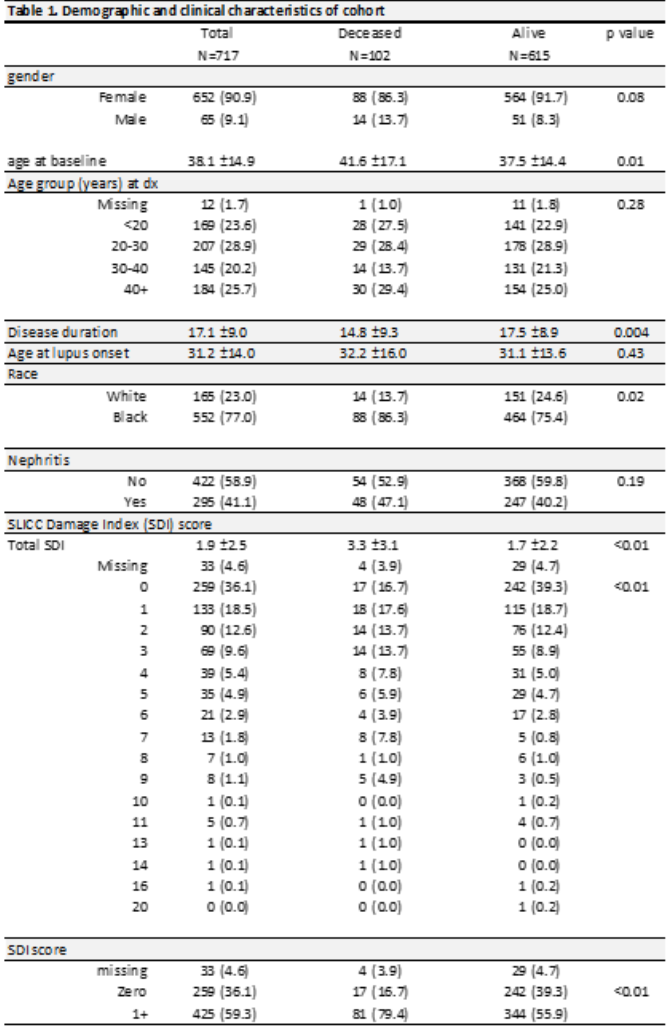Session Information
Date: Sunday, November 12, 2023
Title: (0176–0195) Healthcare Disparities in Rheumatology Poster I: Lupus
Session Type: Poster Session A
Session Time: 9:00AM-11:00AM
Background/Purpose: The goal of this study is to identify characteristics of socially vulnerable environments associated with increased mortality in a South Carolina systemic lupus erythematosus (SLE) cohort.
Methods: Address, demographic, medication use, and SLE International Collaborating Clinics (SLICC) disease damage data were gathered prospectively from patients and their medical record enrolled in the Medical University of South Carolina’s (MUSC’s) lupus registry that met SLE criteria. Death certificate data for patients in the cohort were obtained from the state Department of Health. Standardized mortality ratios (SMR) were calculated using expected mortality rates from the CDC WONDER database, and characteristics between deceased and living patients were compared. The cohort was linked with geospatial analysis to publicly available census tract contextual data, which was CDC’s Social Vulnerability Index (SVI). Then, we applied spatial regression models to assess associations between neighborhood characteristics and SLE outcomes after controlling for age, sex, education, disease characteristics and also examined effect modification of each characteristic by presence of disease damage
Results: 712 subjects were included in the final analysis, and 102 died before the study data cutoff. The total SMR adjusted for age, race, and gender was 12.29 (95% CI 9.97-14.61). Of the deceased, there was a statistically significant increased mortality in association with self-identified Black race (p=0.02), with high vulnerability census tracts, and total, renal-related, and steroid-related SLICC damage index (SDI) of 1 or more (p< 0.01) and a reduced mortality associated with hydroxychloroquine use. Black patients had higher SDI compared to White patients. Patients with SDI of 1 or more were at increased risk of mortality if they lived in a minority neighborhood, had no high school diploma, had low socioeconomic status, or spoke English less than well
Conclusion: Mortality and SDI were significantly greater in Black patients, which, as race is a social construct, prompted evaluation of socially vulnerable environments using SVI which found an increased risk of mortality in socially vulnerable census tracts and this effect was greater in patients with disease damage. The cause of this association is not known. However, the significant association between socially vulnerable environments and mortality suggests the need to study environmental factors that influence the high rate of mortality among lupus patients in SC and should prompt awareness. The significant association between hydroxychloroquine and lower mortality is consistent with other prospective cohort studies and reinforces the current guidelines regarding its use in SLE.
To cite this abstract in AMA style:
Carter S, Wilson D, Minkin S, Dillon D, Murray B, Pearce J, Oates J. Social Vulnerability Associations with Mortality in a Lupus Cohort [abstract]. Arthritis Rheumatol. 2023; 75 (suppl 9). https://acrabstracts.org/abstract/social-vulnerability-associations-with-mortality-in-a-lupus-cohort/. Accessed .« Back to ACR Convergence 2023
ACR Meeting Abstracts - https://acrabstracts.org/abstract/social-vulnerability-associations-with-mortality-in-a-lupus-cohort/


